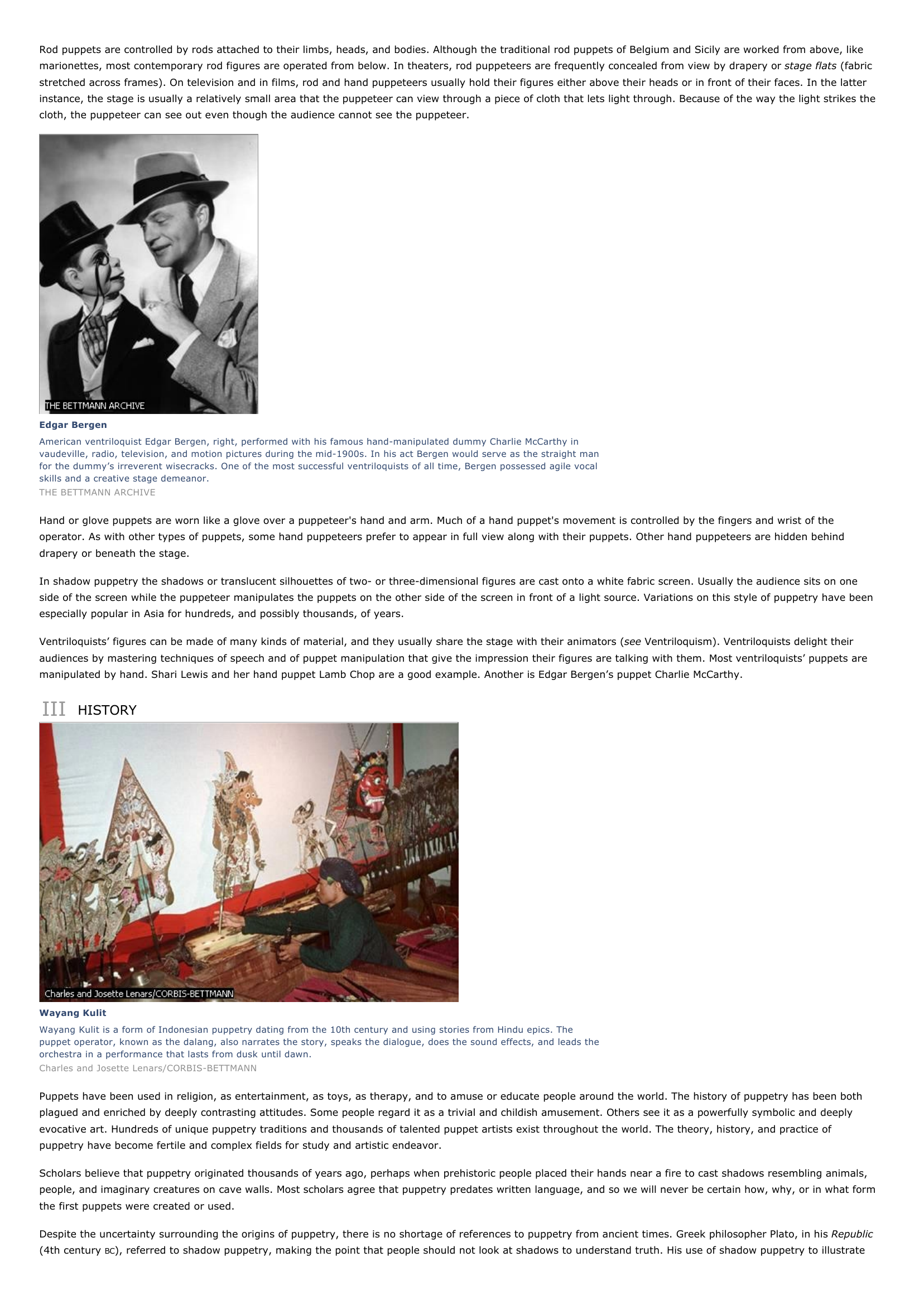Puppets I INTRODUCTION Punch and Judy Punch and Judy are characters in an English hand puppet show that first appeared in 1662.
Publié le 12/05/2013

Extrait du document
«
Rod puppets are controlled by rods attached to their limbs, heads, and bodies.
Although the traditional rod puppets of Belgium and Sicily are worked from above, likemarionettes, most contemporary rod figures are operated from below.
In theaters, rod puppeteers are frequently concealed from view by drapery or stage flats (fabric stretched across frames).
On television and in films, rod and hand puppeteers usually hold their figures either above their heads or in front of their faces.
In the latterinstance, the stage is usually a relatively small area that the puppeteer can view through a piece of cloth that lets light through.
Because of the way the light strikes thecloth, the puppeteer can see out even though the audience cannot see the puppeteer.
Edgar BergenAmerican ventriloquist Edgar Bergen, right, performed with his famous hand-manipulated dummy Charlie McCarthy invaudeville, radio, television, and motion pictures during the mid-1900s.
In his act Bergen would serve as the straight manfor the dummy’s irreverent wisecracks.
One of the most successful ventriloquists of all time, Bergen possessed agile vocalskills and a creative stage demeanor.THE BETTMANN ARCHIVE
Hand or glove puppets are worn like a glove over a puppeteer's hand and arm.
Much of a hand puppet's movement is controlled by the fingers and wrist of theoperator.
As with other types of puppets, some hand puppeteers prefer to appear in full view along with their puppets.
Other hand puppeteers are hidden behinddrapery or beneath the stage.
In shadow puppetry the shadows or translucent silhouettes of two- or three-dimensional figures are cast onto a white fabric screen.
Usually the audience sits on oneside of the screen while the puppeteer manipulates the puppets on the other side of the screen in front of a light source.
Variations on this style of puppetry have beenespecially popular in Asia for hundreds, and possibly thousands, of years.
Ventriloquists’ figures can be made of many kinds of material, and they usually share the stage with their animators ( see Ventriloquism).
Ventriloquists delight their audiences by mastering techniques of speech and of puppet manipulation that give the impression their figures are talking with them.
Most ventriloquists’ puppets aremanipulated by hand.
Shari Lewis and her hand puppet Lamb Chop are a good example.
Another is Edgar Bergen’s puppet Charlie McCarthy.
III HISTORY
Wayang KulitWayang Kulit is a form of Indonesian puppetry dating from the 10th century and using stories from Hindu epics.
Thepuppet operator, known as the dalang, also narrates the story, speaks the dialogue, does the sound effects, and leads theorchestra in a performance that lasts from dusk until dawn.Charles and Josette Lenars/CORBIS-BETTMANN
Puppets have been used in religion, as entertainment, as toys, as therapy, and to amuse or educate people around the world.
The history of puppetry has been bothplagued and enriched by deeply contrasting attitudes.
Some people regard it as a trivial and childish amusement.
Others see it as a powerfully symbolic and deeplyevocative art.
Hundreds of unique puppetry traditions and thousands of talented puppet artists exist throughout the world.
The theory, history, and practice ofpuppetry have become fertile and complex fields for study and artistic endeavor.
Scholars believe that puppetry originated thousands of years ago, perhaps when prehistoric people placed their hands near a fire to cast shadows resembling animals,people, and imaginary creatures on cave walls.
Most scholars agree that puppetry predates written language, and so we will never be certain how, why, or in what formthe first puppets were created or used.
Despite the uncertainty surrounding the origins of puppetry, there is no shortage of references to puppetry from ancient times.
Greek philosopher Plato, in his Republic (4th century BC), referred to shadow puppetry, making the point that people should not look at shadows to understand truth.
His use of shadow puppetry to illustrate.
»
↓↓↓ APERÇU DU DOCUMENT ↓↓↓
Liens utiles
- Steven Spielberg I INTRODUCTION Steven Spielberg The imaginative films of Steven Spielberg are known for their technical creativity and memorable characters.
- Matrix Theory and Linear Algebra I INTRODUCTION Matrix Theory and Linear Algebra, interconnected branches of mathematics that serve as fundamental tools in pure and applied mathematics and are becoming increasingly important in the physical, biological, and social sciences.
- Oliver Cromwell I INTRODUCTION Oliver Cromwell (1599-1658), leader in the English Revolution (1640-1660) and the first commoner to rule England.
- Galileo I INTRODUCTION Galileo (1564-1642), Italian physicist and astronomer who, with German astronomer Johannes Kepler, initiated the scientific revolution that flowered in the work of English physicist Sir Isaac Newton.
- Vladimir Lenin I INTRODUCTION Vladimir Lenin (1870-1924), Russian revolutionary leader and theorist, who presided over the first government of Soviet Russia and then that of the Union of Soviet Socialist Republics (USSR).










